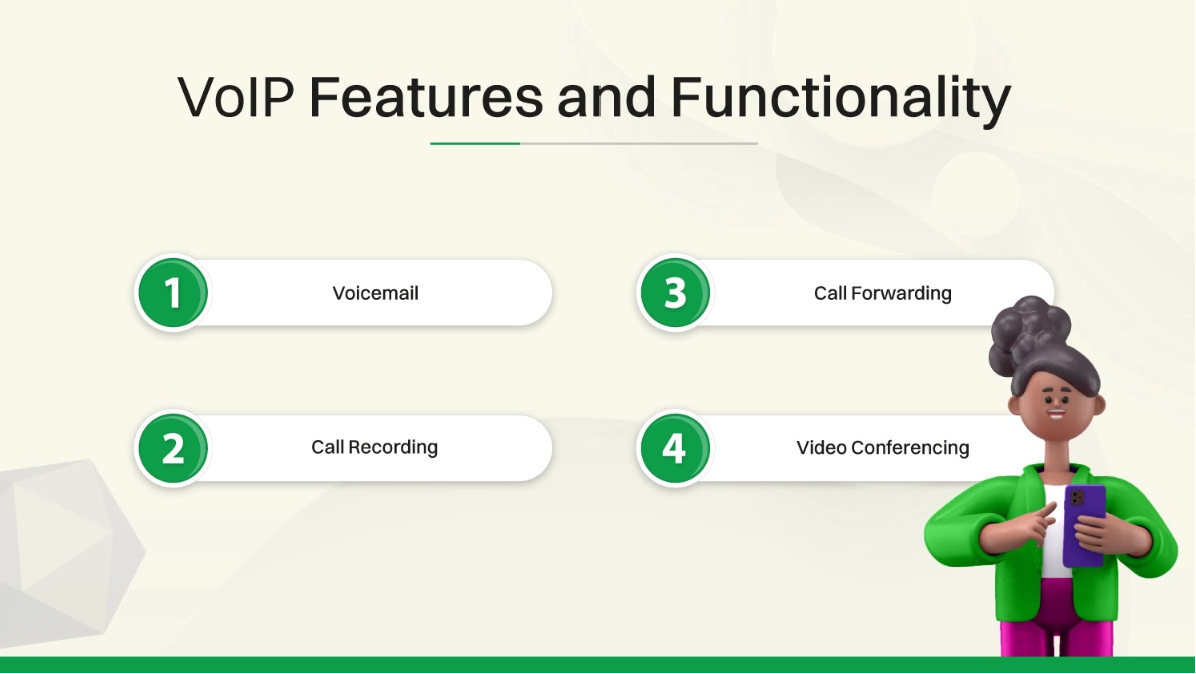Mastering the Art of VoIP: Tips and Tricks

Over time, technology has evolved a lot, starting from pigeons and post offices to telephones and now VoIP.
Several technologies have come and gone, and people always wanted more and better; some tech faded away because of their inconsistency, and some adapted themselves to be the best. One of the best examples of this tech is VoIP, aka Voice Over IP, which has radically transformed how businesses and individuals communicate.
In this blog, we will dive deeper into the art of VoIP and the techniques to master them. So stay connected to learn everything about the communication giant “VoIP,” from its origin to its probable future trends.
What is VoIP?
VoIP stands for Voice over Internet Protocol. In short, it's a recognized set of rules governing the sending and receiving of voice data over computer networks. It allows devices to communicate by phone without requiring wired telephone lines.
Voice over IP or VOIP technology, which helps people communicate online, came out in 1995. When it was first put into service for the general public, not only were heavy hardware and software needed, but the quality of transmission was poor, too.
In the mid-90s, some firms divined possible applications for VoIP and began assisting in its improvement. This gave rise to the successful evolution of a fully equipped technology for communication, that which exists now: VoIP.
Setting Up VoIP
Setting up Voice over Internet Protocol (VoIP) involves several key steps to ensure a smooth and reliable communication system. Here’s a brief guide to set.
Choosing the Right VoIP Service Provider
Selecting an appropriate VoIP service provider involves evaluating pricing, features, reliability, and customer support. To choose the best service provider that fits your business purpose, first analyze your business needs and then spend most of your time researching based on the needs.
Hardware and Software Requirements
Setting up VoIP requires some suitable hardware, such as VoIP-enabled IP phones, PCs, or adapters. If you opt for a cloud-based VoIP system, then you will be free of all these hassles. Make sure that the hardware and the software are fully compatible with your VoIP service providers so everything will work as expected.
Internet Connection Considerations
As VoIP systems are entirely based on the internet, you really need to have a good connection. You should, therefore, ensure stable and clear VoIP communication by checking your bandwidth requirements, prioritizing voice traffic, and considering factors like latency and jitter.
VoIP Call Quality
Making calls with VoIP relies on various factors that affect call quality. For instance, network latency and jitter are key factors. High latency can cause delays, and jitter causes stuttering audio and packet loss produces disconnects. Secondly, hardware quality and stability of Internet access influence call quality.
In a similar way, VoIP calls can be destroyed by audio codecs and quality settings. Codecs transform audio data from an analog form to digital code, which involves bandwidth and quality issues. However, users can choose their own bitrate and sample rate to strike a compromise.
Consequently, bandwidth management is indispensable to avoiding problems such as poor audio quality or dropped calls. Besides quality of service, you must be equally concerned about the amount and use of bandwidth; otherwise, your VoIP calling won't have a reliable experience.
VoIP Features and Functionality

VoIP has several cool features and functionality; some of them are discussed below.
Voicemail
VoIP-based telephony supports voicemail systems. In addition, you can save messages as text files; then, your email inboxes become places for reviewing voicemails. Moreover, users are often capable of recovering voicemails through web portals or mobile applications, making management and retrieval as convenient in use as possible.
Users can convert messages to text and have them forwarded into the recipient's email inbox, providing a handy way of reviewing voice mails. What's more, users normally are able to get at voicemails with web portals or mobile apps. This provides very flexible control and recovery of the calls.
Call Forwarding
Users can customize forwarding rules based on specific conditions with VoIP call forwarding. For instance, the location to which calls are forwarded can differ at different times of day, when certain persons call, or according to whether the user is available. This flexibility helps make sure that important calls are never missed and can be quickly routed to the proper destination.
This is one of the most advantageous features for call centers based on VoIP, which have to handle large groups of calls at once.
Call Recording
Call recording is another useful tool provided by VoIP, enabling the simple recording and storage of conversation for later reference or auditing. It's the ideal business review tool, helping businesses to quickly reference discussions and call data and conduct a thorough analysis of customer or employee calls.
Video Conferencing
Voice is not the only link between people, and if access to a landline network can be extended over the Internet, then VoIP has also devoted some thought to using video conferencing. Virtual meetings alone have made it possible for more effective cooperation at work from distant places.
VoIP Security

As mentioned earlier, VoIP is entirely based on the Internet, so there are always security challenges that may undermine the confidentiality or integrity of the conversation.
Some of the most popular threats include Eavesdropping. This occurs when malefactors intercept and monitor communication channels to get beyond the authorization barrier in order to steal sensitive information. Moreover, other cyberattacks include phishing, Denial of Service (DoS) attacks, toll fraud, malware, and viruses.
Best Measures for VoIP Security
Several advanced security arrangements are essential to secure your VoIP environment from these threats. Some of the best industry-in-use practices for VoIP security are as follows.
- Strong Authentication
- Encryption
- Network Segmentation
- Firewall
- Intrusion Detection System
- Regular Software Updates
- Employee Training
VoIP Protocols+
Voice over Internet Protocol (VoIP) is based on several protocols that let voice data be transmitted via digital networks. Some of the important protocols are fo
- Session Initiation Protocol (SIP): SIP is a signaling protocol for initiating, modifying, and ending communication sessions (like phone calls) on an IP network. It is also generally used to begin and control VoIP calls.
- Real-Time Transport Protocol (RTP): RTP is a means for communicating audio and video data. This guarantees the timely transmission of live streaming media and helps to synchronize voice and video over e-net.
- H.323: The protocol suite includes standards for audio, video, and data communication on the Internet. Though H.323 is later than SIP, it does enjoy a niche in some VoP applications, such as video conference systems.
- Media Gateway Control Protocol (MGCP): MGCP is a signaling and control protocol that allows communications between the media gateway's call control devices. This is the most popular means of controlling voice and fax traffic over VoIP.
Troubleshooting VoIP Issues
Some of the tips to troubleshoot general VoIP issues are as follows.
- Eliminate common problems by inspecting cables, adjusting router QoS settings, reviewing WiFi connectivity, and keeping software/firmware updated.
- WAN issues and damaged cables that disrupt VOIP can be resolved by resetting devices, upgrading hardware, configuring router prioritization, disabling the SIP gateway, and reconfiguring the LAN.
- To tackle jitter, optimize ping, use specialized monitoring tools, and ensure network conditions support VoIP calls.
- For other audio issues, check for packet losses insufficient bandwidth, and ensure a fast internet connection, considering the microphone source is already good.
- For advanced VoIP debugging, you can make use of SIP commands, analyze signaling with Wireshark, utilize protocol debuggers like tcpdump, monitor Ethernet traffic, inspect debugging displays, use call tracing tools, and specialized monitoring tools like SolarWinds VoIP & Network.
VoIP for Business
VOIP smoothly blends into business operations, making communication among employees, customers, and partners more efficient. It easily fits with existing systems and CRM tools, and thus, you can even create a unified way to communicate.
And here's the budget-friendly side: VoIP saves businesses money compared to traditional phone systems. Less hassle with infrastructure and maintenance means more budget flexibility, especially when it comes to international and long-distance calls. VoIP providers often have plans that won't empty your pockets, offering reasonable per-minute rates.
But wait, there's more! VoIP is definitely not a one-size-fits-all. It is like a business toolkit, with options to suit all budgets. With cool features such as unified communications, video chats, and smart call routing, these solutions grow with the business. Therefore, enterprises can select the best thing for their business without being burdened with extras.
Also Read: Best business tools.
Mobile VoIP
VOIP services don’t need to be confined within particular infrastructural setups. You can now do that on your mobile phone using various VOIP applications. It provides users with the ability to make and receive calls from anywhere with an internet connection. Software like Google Voice, WhatsApp, KrispCall, etc., are some examples.
Another huge advantage of mobile VoIP is its immediacy. Getting started with mobile VoIP is simple on most popular mobile devices. You just need to have an active internet connection (Wi-Fi or cellular), download a VoIP app, set up your details, and you can start making voice calls on smartphones or tablets easily.
VoIP Trends and Future Developments
The future of VoIP is bright and promising, with an expected CGAR growth of 15% from 2021 to 2027. These are some of the trends and future developments of VoIP to look beyond 2024.
- 5G Integration: The integration of 5G and VOIP with advanced techs like beam forcing, Massive MIMO, and network slicing makes VoIP services possible with higher speed, lower latency, and stronger reliability for users on the go.
- AI in VoIP: AI-powered tools like a virtual receptionist, intelligent call routing, auto voice transcription, and sentiment analysis can help analytics and sentiment analysis automate various processes and improve callers' efficiency. AI can even help to enhance call quality, voice cloning, etc.
- Blockchain in VoIP: Integration of blockchain with VoIP improves security, preventing tampering of data while keeping records on a decentralized, transparent ledger. This reduces several frauds and scams like toll frauds while maintaining authenticity.
- IoT Integration: VoIP with IoT devices gives smart systems the ability to be communication-optimized, context-aware, and performant by integrating itself with interconnected devices. In addition to enhancing work efficiency, it also opens up many potential breakthrough applications in fields such as intelligent homes and automated industrial control.
- Cloud Computing in VoIP: The growing adoption of cloud-based VoIP solutions provides businesses with scalable, flexible, and cost-effective communication services, removing the requirement of external hardware.
Conclusion
In short, getting your VoIP up to speed means overcoming the setup hurdles and perfecting both hardware configurations and security. With features such as advanced voicemail and flexible call forwarding, VoIP fits smoothly into the modern business communications scene.
Looking forward, trends such as 5G, AI (artificial intelligence), blockchain technology, IoT, and cloud computing will further improve the VoIP experience. Now that you have all these understandings, set sail courageously onto the changing waters of VoIP, where innovation and communication await! Happy communicating!
Also Read: INTERNET OF THINGS (IOT) AND 5G INTEGRATION
